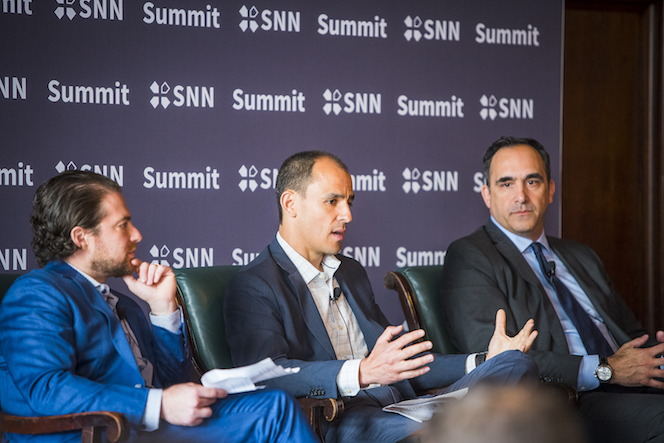Though the leasing relationships between real estate investment trusts (REITs) and their skilled nursing tenants have come under scrutiny — and criticism — in recent months, it may be premature to declare their permanent demise.
“There’ll be health care — broadly defined — REITs that’ll move in and out of the sector, upsize and downsize,” Frank Small, chief investment officer at Greystone Health Care Investments, said at the inaugural Skilled Nursing News Summit in Chicago last week. “But I don’t really see the fundamental REIT structure going away.”
Major REITs have long played a role in the nursing home operational landscape, with some former owner-operators choosing to sell their real estate to unlock the equity they’d built up in their physical plants.
But the CEO of one of the nation’s largest SNF operators, George Hager of the Kennett Square, Pa.-based Genesis HealthCare (NYSE: GEN), made headlines earlier this year for describing the traditional skilled nursing-REIT structure as “a failure,” painting standard rent escalators as potentially deadly for operators struggling with reimbursement pressures and other persistent issues.
“You’ll continue to see some portfolios in traditional structures be sellers,” Hager predicted.
The CEO’s remarks this past winter were part of a growing industry reckoning with the lease structures between REITs and their operating tenants. One operator that filed for bankruptcy, the Dallas-based Senior Care Centers, specifically pointed to “expensive leases” in its Chapter 11 filing late last year. And a January report from Green Street Advisors found that skilled nursing rents had to decline by about 10% to ensure the stability of facilities.
But overall, the panelists tasked with discussing mergers-and-acquisitions trends at the SNN Summit felt that REITs have come a long way from the years of outsized rent escalators.
REITs in general have become more sophisticated when it comes to the operational and clinical aspects of SNFs, which allows them to underwrite deals more skillfully than they were a decade ago, Isaac Dole, founder and managing partner of the Chicago-based Birchwood Healthcare Partners, argued.
“I think there’s a flight toward quality right now,” Dole said on the panel. “So when [the REITs] are underwriting a prospective tenant, they’re no longer just looking at the tenant’s balance sheet. They’re looking at the actual capabilities of that tenant. They’re deeply understanding the leadership team, the outcomes that they’ve executed historically.”
That push towards quality has extended to transitions of facilities within a REIT’s portfolio, he added: Not only are REITs actively trying to move properties to their highest-quality operators, they’re willing to take rent concessions to make those handoffs happen, Dole said.

Still, REIT deal volume and pricing for SNFs reached an all-time high in 2016, Ben Firestone, senior managing director and founding partner at Blueprint Healthcare Real Estate Advisors, added. Since then, for several reasons, net operating incomes (NOIs) have been “compressed,” he said.
“You’re seeing a lot of REITs as net sellers of skilled nursing,” Firestone said. “And that’s what I’d say we’re busy with more than anything, is helping REIT investors unwind skilled nursing transactions.”
PDPM’s dealmaking whimper
Many REIT leaders made predictions last year that the upcoming overhaul to Medicare reimbursement, the Patient-Driven Payment Model, would lead to a wave of SNF transactions as smaller, family-owned SNFs decided to exit the space.
But while PDPM represents one more variable that might make leaving the space more attractive for operators, as Dole observed, it hasn’t quite played out that way — at least as of now.
“We have not seen people crowding to the exit, at least yet, for PDPM,” Firestone said. “I think the theme you’re going to see is NOIs hopefully neutral … it seems like the revenue may go down, but the costs associated with providing therapy may also, and it may be a net neutral. So I think long-term optimism will prevail.”
In fact, at an earlier panel, one speaker argued that buyers and sellers aren’t being optimistic enough about the new system, as current asking prices for SNFs don’t account for the potential cost savings the new system could bring.
“I think a lot of the deals I’m looking at now, currently, we’re not really seeing those expense reductions baked in — and I think it’s an opportunity,” Vincent Fedele, director of analytics at consulting firm Zimmet Healthcare Services Group, said.
Greystone has begun including PDPM math into its underwriting, comparing historical performance of SNFs to various PDPM projection models, Small said — while also adding that he had expected “more of a rush to the exits” given the initial anxiety around the payment model, which has since abated.
“There’s more optimism, it seems, around what PDPM will result [in],” Small said.
Companies featured in this article:
Birchwood Healthcare Partners, Blueprint Healthcare Real Estate Advisors, Greystone



